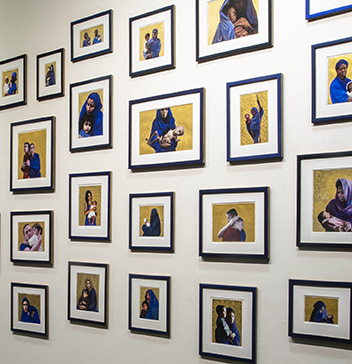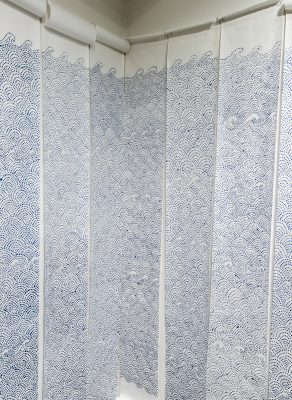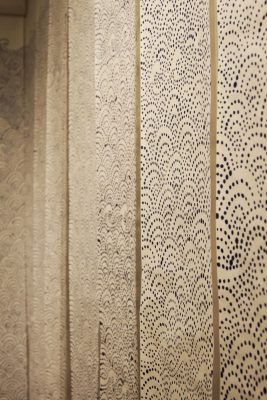Nancy Jenner: World News: Alternate Views
By S. Scarlett Moberly
Just off the main corridor of Hollister Hall at Babson College is a small exhibition space tucked into the recess below a stairwell. For the month of February, a wide wall in this alcove bore 54 small photographs of parents holding their children, isolated from context by shimmering gold backgrounds. Hung salon-style, they were clustered together like a wall of family photos. The clothing of the parents painted over a deep ultramarine and the gold backgrounds studded like radiating halos, from afar they read as devotional icons in the early Christian tradition. However, in these images the devotion is not religious, but that of parents to their children in the face of chaos and strife.
The series, World News Madonnas by artist Nancy Jenner, grew from press images accompanying stories of war and famine. The images are familiar – they come from the wars in the Middle East, the refugee crisis in Europe and most recently, the famine in Yemen and the migrant crisis at the U.S. southern border. Jenner grew up in the pre-digital age, when news images were black-and-white photographs in newspapers or grainy reels on the evening news. She never liked reading broadsheet papers, preferring to get the news from radio broadcasts until just a few years ago, when Jenner bought an iPad. She began reading the New York Times online and was struck by the clarity and color of the images that accompanied the articles. “iPad news was a revelation,” says Jenner, who began to collect the photographs she found most striking, often of mothers and children. Jenner’s work is influenced by art history, and so she readily saw the parallels between images of parents carrying children and the Madonna and Child paintings from Christian art and beyond. Printing out her collection, Jenner realized that as she separated the parents and children from their backgrounds, she emphasized the humanity of the figures and the universally sacred notion of the parental bond.
While Christian devotionals are idealized and symbolic, Jenner’s subjects are real, more like portraits than icons. World News Madonnas celebrates people, Jenner says, not any god. Scanning their faces, one sees fear, bravery, levity, determination, defiance. There are moments of quiet tenderness, as a closed-eyed child riding the shoulders of her father leans over to rest her head on his. An empathetic viewer might find one’s facial muscles pulling into the expressions in the photos. Emotional muscle memory falls short at an image of abject misery, as a mother with sunken features holds out her skeletal child in a heart-wrenching pietà. Few know anguish like this. By separating the relationships from the chaos, Jenner forces the viewer to contemplate the human toll of these events.

Installation view of World News Madonnas by Nancy Jenner. Photo by Carl Tremblay. Courtesy of Nancy Jenner.
Jenner understands the potentially problematic nature of the series. “Because some of the recent images are particularly difficult, the question I grapple most with is, am I, by creating beautiful images of crisis and drama, honoring the men, women and children who are represented? [Am I] raising the right questions or am I perpetuating a position of voyeur, rubbernecking to observe or even glamorize the drama of others?” Jenner noted that apart from those of migrants seeking to enter across the Mexican border, it’s nearly impossible to find news images like these of people in the United States, though she did find one from the fires in California last year. That fact raises still more questions about what types of stories the American media perpetuates, and which lens Americans use to look at themselves rather than those inhabiting the rest of the world. There are clearly parent-and-child victims of hunger, natural disasters and racial violence in this country. Where are those images? Do Americans distract from this nation’s failings by highlighting the crises of others? Do we romanticize the other by dramatizing their pain? The important thing, Jenner says, is not to answer these questions, but to ask them.
Adjacent to World News Madonnas is Pollution Math. After reading that the U.S. consumes 90,000 water bottles per minute, “I was gobsmacked,” says Jenner. She knew she had to incorporate this statistic into an artwork, yet the form took longer to take shape than did the Madonnas. “I made a water bottle stamp, printed pictures of plastic,” Jenner begins, “but I wanted to commit to the number.” Cautious of the commodification of art and the production of ever-more things, Jenner sought to avoid creating waste, particularly for a piece critiquing over-consumption. She landed on rice paper scrolls dotted with India ink. Fragile, compostable, able to store compactly (“roll them up, put them in a shoebox”), the result is simple and graphic. She began making the wave pattern to represent water in general and specifically plastic waste in the ocean before she realized she knew the reference: the seigaiha pattern, common in Japanese art, represents water abstractly and is often an omen of good luck. “Pollution Math is an immersive infographic,” says Jenner, “not dissimilar to the infographics we see in our online feeds, with the added layer of scale and time – the time it took to handcraft the dots and the amount of paper needed to contain them.” Ten scrolls containing 90,000 dots resulted. “When I was finished, I did the math. My rate of painting dots was 83 dots per minute. To paint 90,000 dots took approximately 1,084 minutes. During that time, more than 97 million water bottles were consumed in the U.S.”


Details of Pollution Math, India ink on rice paper. Left: Photo by Carl Tremblay. Right: Photo by Taline Karozichian. Both courtesy of Nancy Jenner.
The materials used in Pollution Math – rice paper, India ink, the seigaiha pattern – also point to the history of colonization and globalization, and how those phenomena led to capitalism and mass consumption, which in turn have contributed to pollution and the degradation of the environment. As with World News Madonnas, the point of the work is not to offer answers to the questions it raises, “only to provide perspective and, perhaps, cause us to be more circumspect in our conclusions and more motivated in our advocacy.”
World News: Alternate Views was recently on view at Hollister Gallery at Babson College in Wellesley, MA. More of Nancy Jenner’s work can be viewed at nancyjennerartwork.com.
